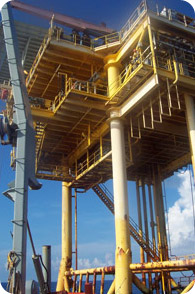Offshore oil rigs and other man-made structures in the sea attract large numbers of fishes and other marine life. But have you ever wondered why? It’s the same reason coral reefs contain so many kinds of life - complexity.
 Offshore oil rig in the Gulf of Mexico. Photo: Brad Gemmell
Offshore oil rig in the Gulf of Mexico. Photo: Brad GemmellFlat, sandy bottoms and open water offer very little structure for organisms to live in or on. In these featureless areas, fish densities tend to be low. However, like the corals on a reef, oil platforms add complexity to the open ocean, and become the foundation for what are essentially artificial reefs.
All over the planet complex habitats support a great diversity of life. Tropical rainforests, for example, contain many more species of birds than other types of forests because of their complex blend of different foliage.
There is some controversy about whether artificial reefs increase productivity or merely attract organisms from other places, but one thing is clear, there are many different plants and animals around these structures. Some are drawn to the protection the platforms provide - there is practically no place to hide in open water. Others find the bountiful array of organisms that attach and grow on the structure, such as corals, sponges, and barnacles, an irresistible food source. Predators are attracted by all the other animals that gather there. Entire communities form on these complex structures, from invertebrates to fishes, turtles, birds, and even whales.
 Offshore oil rig in the Gulf of Mexico. Photo: Brad Gemmell
Offshore oil rig in the Gulf of Mexico. Photo: Brad GemmellWhile these man-made structures may not be as complex as a natural reef, there is certainly enough to establish an island of life.
copyright 2006, The University of Texas Marine Science Institute


